Mariam’s Tomb Is A Mughal Architectural Marvel In Agra To Visit In 2026
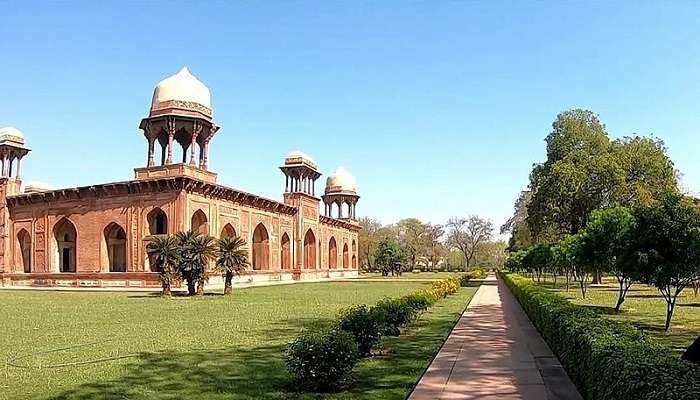
It’s not just a building that symbolises history located in the middle of the growing city of Agra; it is Mariam’s tomb. It is the story of love woven with the beautiful art of painting, with elements of loss interwoven perfectly in the fabric of Mughal painting. The Tomb of Mariam-uz-Zamani, or Mariam’s tomb, is the mausoleum of Mariam-uz-Zamani, commonly known as Jodha Bai, the favourite wife of the Mughal Emperor Akbar. Her son Jahangir built the tomb; in her memory, it is time to examine its historical background, infrastructure features, and tourist attractions.
A Deeper Look At The History
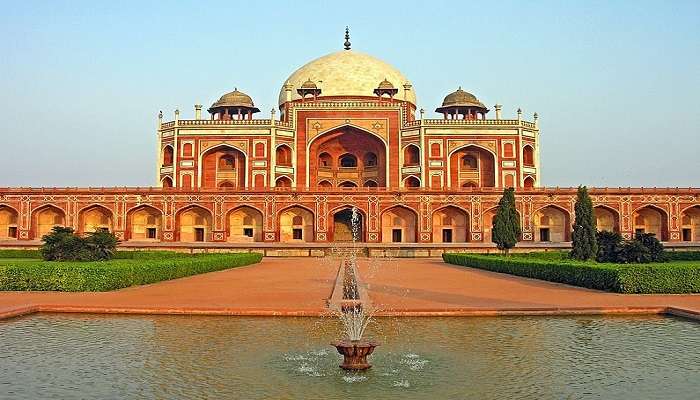
Jodhaa Bai: The Mystery of the Mausoleum: Some records differ, but the generally accepted view is that Jodha Bai or Mariam-uz-Zamani was Emperor Akbar’s favoured wife. As a Rajput woman with political strategic abilities, she maintained unity and order within the Mughal Empire. This account, in turn, indicates how much Mariam meant to Akbar and how much respect he earned for her.
Beyond the Taj Mahal’s Shadow: Going by what is seen in Mariam’s Tomb, the grand structure thus offers an entirely different aspect of the Mughal architecture than what can be seen in the Taj Mahal. Built during the early seventeenth century, the monument can be best characterised as an example of the transition period when the Magul architecture gradually started to undergo Hinduization. This fusion is seen in the architecture of the octagonal tomb chamber and the chhatris, which were built to complement Jodhaa Bai’s Rajput heritage.
A Symbol of Tolerance: Mariam’s Tomb represents one of the many dimensions that marked the reign of Akbar, the Mughal emperor who was a crusader of religious tolerance. The integration of Hindu and Islamic architecture shows that the emperor was trying to unite people of two different cultures to form a single empire.
Must Read: Manghatai In Uttar Pradesh
Unveiling The Architectural Nuances
Here are the monument’s architectural nuances you must know before visiting.
1. The Char Bagh’s Legacy
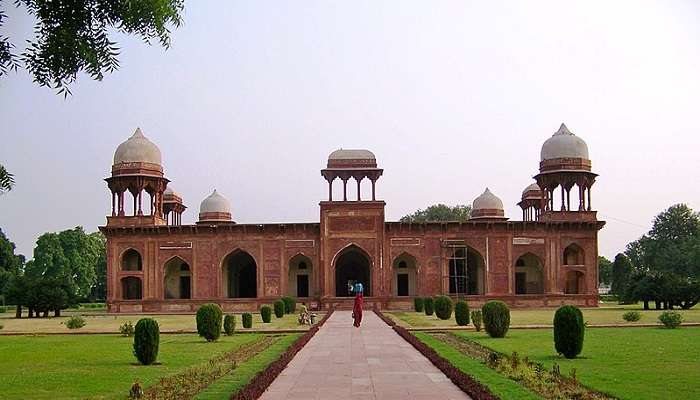
The tomb complex’s garden design has a Char Bagh layout, forming the Mughal Gardens’ principal feature. This garden layout has two matching gardens, each consisting of four parts that symbolise paradise and elements, respectively. These problems suggest experiencing the Char Bagh as generating the aura of order and calm inside the mausoleum.
Tip: Follow the rules of visiting the place.
2. Jali Work: A Play Of Light And Shadow

Jali’s work also encloses the tomb, depicting it with a touch of elegance and usefulness for the monument. These screens facilitate natural lighting and air in the tomb chamber, further enhancing the overall mood and ambience of the area.
Tip: Visit the place during the evening to witness the light show.
Suggested Read: Shri Mankameshwar Mandir
3. Floral And Geometric Motifs
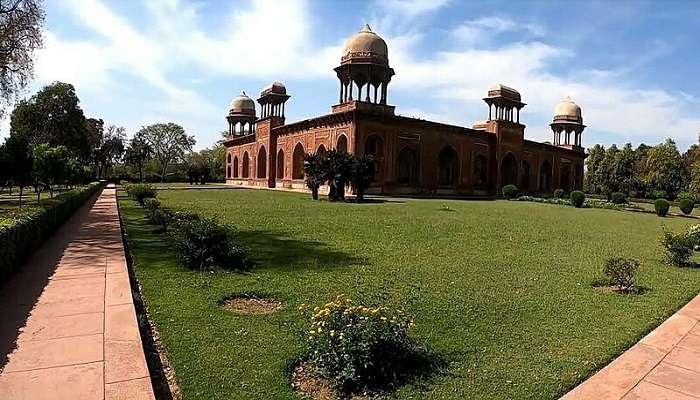
Floral and geometric carvings are presented on the exterior façade of red sandstone. These motifs, which depict vines and geometric figures, which are also very characteristic of Mughal decorative art, introduced the depth of decorations and are the signs of the attempts to create high-quality products.
Tip: You can get souvenirs from the place.
A Multifaceted Visitor Experience
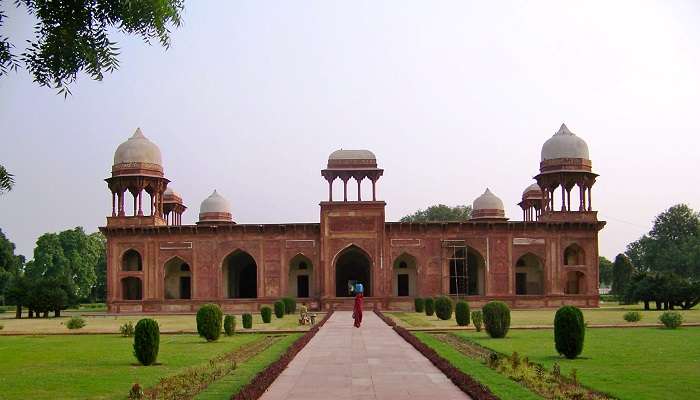
A Haven for Photography Enthusiasts: Completed in red sandstone with white marble towers and landscaped lush green Char Bagh, it is a pleasure for photographers. Meticulously photograph the buildings’ details and the gardens’ tranquillity, or use the mausoleum as a stage for posing for a portrait.
A Historical Learning Experience: Mariam’s Tomb is worth visiting to understand the historical background and the arts of the Mughal Empire. Take a guided tour of the tomb to get maximum information on the lives of Akbar and Jodhaa Bai, the architecture of the tomb complex, and its cultural value.
A Moment of Tranquillity: Escape the crowded City of Agra and find peace in the simple beauty of Mariam’s Tomb. Walk in the Char Bagh, contemplate why it stands there, and admire the everlasting charm of the Mughal structures.
Suggested Read: Mehtab Bagh
Suggested Read: Mehtab Bagh
Beyond The Tomb Walls: Exploring The Surroundings
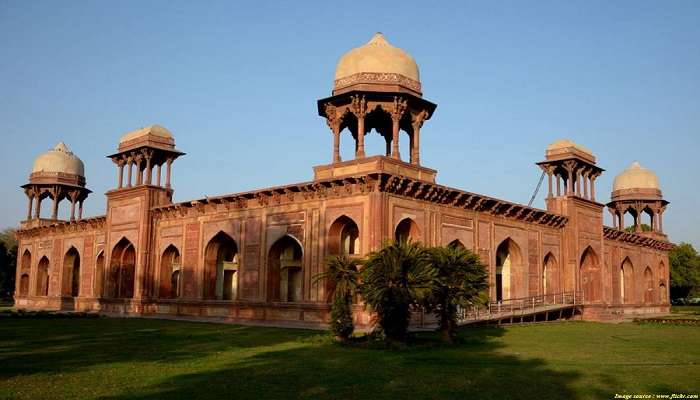
A Journey Through Mughal History: Sikandra is a place of hundreds of historical points of interest, including the tomb of Mariam. Tour the impressive Akbar’s Tomb, a world heritage site, and explore the fusion of architectural styles. Visit the tomb of Jahangir, Jodhaa Bai, and Akbar’s son and learn how the Mughal architecture tombs changed.
A Culinary Adventure in Agra: Having enjoyed the historical site of Mariam’s Tomb, you can travel to taste the diverse food culture. Taste exotic local cuisines from cheap food stalls or order a proper meal at an authentic local restaurant.
Mariam’s Tomb: A Legacy Enduring
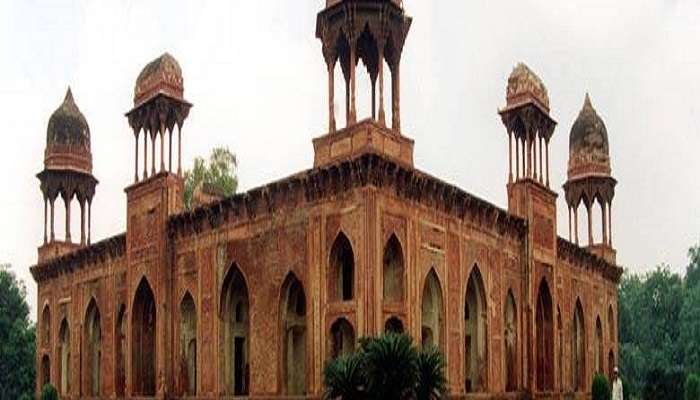
Mariam’s Tomb is a symbol of love and a monument to the beautiful women of the Mughal Empire who lived long ago and are not forgotten even now. It’s not just a sculpture – it is a time machine of sorts, taking people inside the lifetimes of the justice of the dynasty, seeing the ins and outs of a dying celebration spirited in aesthetics. Therefore, the next time you plan to visit Agra, the highlight of your tour should include this historic city and the Unesco World Heritage Site to unveil the treasure that it has in store through its magnificent art and architecture.
Suggested Read: Places To Visit Near Taj Mahal
Exploring Mariam’s Tomb: A Visitor’s Guide
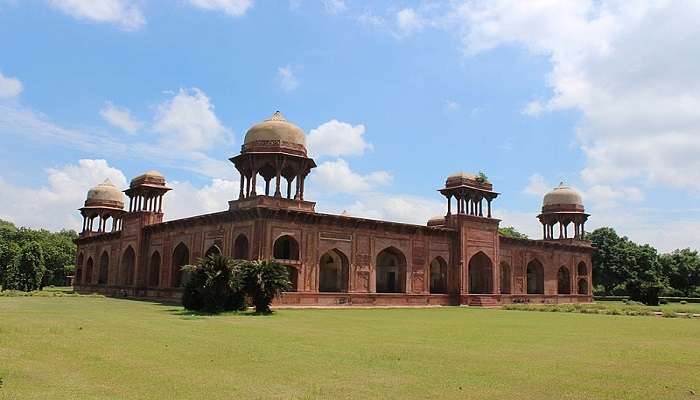
Location: Mariam’s Tomb is conveniently located in Sikandra, Agra, approximately 1 kilometre from Akbar’s Tomb.
Entry Fee: Fortunately, entry to Mariam’s Tomb is free, making it an accessible and budget-friendly attraction for visitors.
Further Read: Pachisi Court
Once more, the construction of Mariam’s Tomb symbolises the magnificent architectural work of the Mughals; however, it symbolises the tragic tale of a lover and her beloved. Apart from the locale that houses the Taj Mahal, It brings out many unknown facets of Mughal rule and elegance. Therefore, next time you plan a trip to Agra, do not miss out on an opportunity to visit this beautiful place which perfectly embodies Indian historical heritage. Specific timings and any changes in that or even special occasions being celebrated at the Mariam’s Tomb can all be sought on the official website of the Archaeological Survey of India (ASI). So, stay ahead and plan your trip to Agra.
For our editorial codes of conduct and copyright disclaimer, please click here.
Cover Image credit : By Nush1125 for Wikimedia Commons.
Frequently Asked Questions About Mariam’s Tomb
How much time should I allocate for visiting Mariam's Tomb?
While Mariam's Tomb is a smaller monument than the Taj Mahal, it still deserves dedicated exploration. Plan to spend around 30-45 minutes appreciating the architecture and gardens and soaking in the historical ambience.
What are the best times to visit Mariam's Tomb?
Early mornings and late afternoons offer the most pleasant weather for outdoor exploration. Avoid visiting during peak tourist hours (mid-morning and afternoon) if you prefer a less crowded experience.
Are there any restaurants or cafes near Mariam's Tomb?
Limited options for food and beverages are available near Mariam's Tomb. However, you'll find a broader range of restaurants and cafes in Agra city centre, especially near the Taj Mahal. Consider grabbing a bite before or after visiting the tomb.
Can I combine a visit to Mariam's Tomb with other attractions?
Absolutely! Mariam's Tomb is conveniently located near other historical sites in Agra. You can easily combine your visit with a trip to Akbar's Tomb, Jahangir's Tomb, or even the Agra Fort, creating a full day of historical exploration.
Is Mariam's Tomb accessible for visitors with disabilities?
Unfortunately, accessibility for visitors with disabilities is limited at Mariam's Tomb. The walkway leading to the tomb complex might be uneven, and the steps leading down to the tomb chamber can pose challenges for those with mobility restrictions.
People Also Read:
Ibrahim Rauza Tomb Safdarjung Tomb Paigah Tombs

Get ready to wander the world through amazing visual tours that we provide via our blogs and stories. As a content writer, I love sharing incredible travel experiences that inspire readers to plan their own adventures and create unforgettable memories. From planning to execution, everything has already been served in these amusing tales. Let’s explore the world together, one destination at a time!











